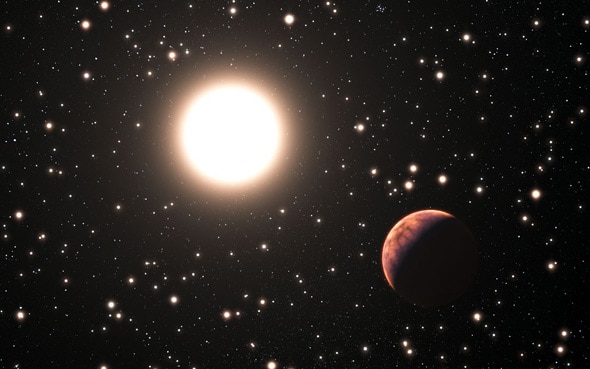Create a free profile to get unlimited access to exclusive videos, sweepstakes, and more!
Astronomers Find a Hellish Exoplanet Orbiting a Twin of the Sun … in a Star
Cluster

Weâre still learning a lot about how planets form around other stars. Over a thousand (!) such exoplanets have been found, giving us a pretty good sample to poke around with. Weâve seen big planets, little planets, hot planets, cold planets, and rogue planets, and weâve seen them around small stars, big stars, dead stars, and binary stars.
The funny thing is, we know most stars form in clusters, condensing out of giant gas clouds en masse. Yet we havenât found very many planets orbiting stars in clusters. Any time a new one is found, itâs important.
And now we can add three more to the roster! Not only that, but one is orbiting a star that is very much like our Sun, enough to be called a solar twin. Thatâs quite interesting indeed.
The planets orbit stars in the open cluster M67, a dense stellar city of about 500 stars located 2,500 light years from Earth.* The cluster is about 4 billion years oldâabout the same age as the Earth and Sunâmaking it one of the oldest clusters known. It probably had many more stars long ago, but most dissipated away over time as they interacted with each other gravitationally, ejecting the lower mass stars (we actually call this evaporation). Most clusters evaporate completely by the time they reach this age, but M67 is dense enough that a few were able to hold on to the old homestead.
One of the host stars is a bit smaller and cooler than the Sun, and another is what we call an evolved star; itâs already become a red giant. The third is the one thatâs so very interesting. YPB 1194, as itâs called, has 1.01 times the mass of the Sun, 0.99 times the radius, and a temperature thatâs virtually indistinguishable from the Sunâs. Since the cluster is about the same age, too, this makes the star one of the very rare solar analogs, or âsolar twin.â
Only a handful of planets have been found orbiting stars so similar to the Sun (for example, HD 187123 and HD 86226), and none in a cluster.
The planet, though, isnât Earth-like at all. Itâs one-third the mass of Jupiter (100 times that of our own planet) and orbits the star once every 6.9 days. That puts it just about 10 million kilometers (6 million miles) from the star, far closer than Earth is to the Sun. Closer than Mercury, even. The surface of this planet (if it has one; itâs likely a gas giant) will be hotter than a blast furnace.
But the point here isnât how clement the weather is on the planet. The point here is that it exists at all. This means that other stars just like the Sun can form planets and that they can do so even when in a cluster, where itâs pretty crowded. We donât know if the Sun formed in a cluster or not, but this new discovery means itâs possible.
Another benefit to this is that itâs likely all the stars in the cluster were formed at the same time, especially relative to their age (whatâs a few million years off if youâre 4 billion years old?). They also formed from the same material, which means the stars can be compared directly; you donât have to worry about different ages or compositions screwing up your data. Together with its proximity and age, this makes M67 a favorite target for astronomers, so we know a lot about it. Thatâll make YPB 1194b a very well-studied planet, too.
I have to wonder, too ⦠what does the sky look like for that planet? Well, the star occupies nearly half of it, so itâs a blazing hellfire of light and heat. Right, so letâs let our minds take a step further out, literally, and suppose thereâs an Earth-like planet orbiting that star at a more comfortable distance.
The star is so similar to the Sun it would probably look exactly the same by eye. The new exoplanet found would be very close to the star from that viewpoint, so it would be extremely bright, brighter than Venus is in our sky. With careful viewing, it would be visible in broad daylight. For a day or two a week it would appear just over the horizon before sunrise and after sunset, glowing fiercely. But imagine this: The star sits in a cluster, surrounded very closely by hundreds of other stars. Many of these would be red giants, shining brighter than Venus, gleaming red in the sky.
What a view that would be! Alas, we have no evidence for such a habitable planet around that star, but itâs possible. Given the rate of new exoplanet discoveries, we may have a far better database built up of such planets in the next few years. I do enjoy letting my imagination picture these worlds, but itâs even more thrilling to know that we have actual data on them. The picture in my mind is based on science, and even better, worlds like that actually exist.
Science! It brings the Universe right into your head.
*Incidentally, M67 is in the constellation Cancer, between Gemini and Leo. It rises just after sunset in the winter, so itâs up in the southeast by the time it gets dark for most observers right now. You can find it with binoculars; just donât confuse it for the much brighter and bigger Beehive Cluster (also called M44, or Praesepe) nearby.


























